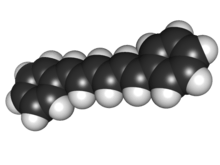Diphenylhexatriene
Diphenylhexatriene is a fluorescent hydrocarbon used in the study of cell membranes. It is almost non-fluorescent in water, but it exhibits strong fluorescence when it is intercalated into lipid membranes. It incorporates itself into the lipid bilayer and acts like a lipid. [2][3]
 | |
 | |
| Names | |
|---|---|
| Preferred IUPAC name
1,1'-[(1E,3E,5E)-Hexa-1,3,5-triene-1,6-diyl]dibenzene | |
| Other names
(1E,3E,5E)-1,6-Diphenylhexa-1,3,5-triene [(1E,3E,5E)-6-Phenylhexa-1,3,5-trien-1-yl]benzene trans,trans,trans-1,6-Diphenylhexatriene Dicinnamyl | |
| Identifiers | |
3D model (JSmol) |
|
| ECHA InfoCard | 100.015.465 |
PubChem CID |
|
CompTox Dashboard (EPA) |
|
| |
| Properties | |
| C18H16 | |
| Molar mass | 232.326 g·mol−1 |
| Melting point | 199 to 203 °C (390 to 397 °F; 472 to 476 K) |
| -146.9·10−6 cm3/mol | |
| Hazards | |
| Main hazards | Irritant (Xi) |
| R-phrases (outdated) | R36/37/38 |
| S-phrases (outdated) | S26 S36 |
Except where otherwise noted, data are given for materials in their standard state (at 25 °C [77 °F], 100 kPa). | |
| Infobox references | |
References
- 1,6-Diphenyl-1,3,5-hexatriene at Sigma-Aldrich
- trans-trans-trans-1,6-Diphenyl-1,3,5-hexatriene Archived 2012-02-24 at the Wayback Machine, Molecule of the Week, American Chemical Society, December 8, 2008
- Litman, B; Barenholz, Y (1982). "[91] Fluorescent probe: Diphenylhexatriene". Biomembranes - Part H: Visual Pigments and Purple Membranes - I. Methods in Enzymology. 81. p. 678. doi:10.1016/S0076-6879(82)81093-8. ISBN 978-0-12-181981-1.
This article is issued from Wikipedia. The text is licensed under Creative Commons - Attribution - Sharealike. Additional terms may apply for the media files.